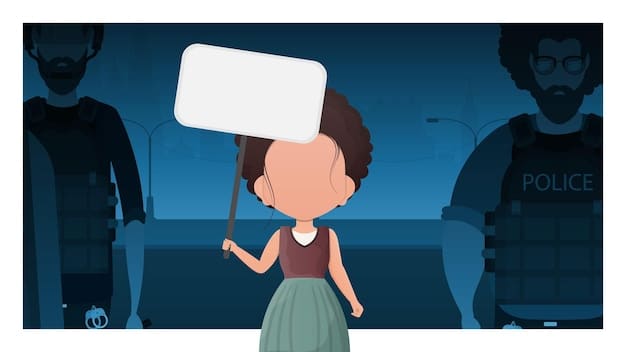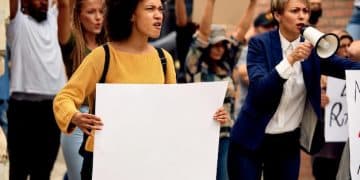Understanding Implicit Bias in Law Enforcement: Promoting Fair Policing

Implicit bias in law enforcement significantly impacts fair policing, leading to disparities in treatment and outcomes for various community groups, necessitating comprehensive strategies to mitigate its effects and promote equitable justice.
The presence of implicit bias in law enforcement poses a significant challenge to the principles of justice and equality. These unconscious biases, shaped by societal stereotypes and personal experiences, can influence officers’ perceptions, decisions, and actions, often leading to disparities in how different community groups are treated. Understanding the pervasive role of implicit bias is the first step towards building a more equitable and just law enforcement system.
The Pervasive Nature of Implicit Bias
Implicit biases are unconscious attitudes and stereotypes that affect our understanding, actions, and decisions. These biases operate outside of our awareness, influencing how we perceive and interact with the world around us. In law enforcement, implicit bias can manifest in various ways, impacting everything from split-second decisions during encounters to broader patterns of policing.
How Implicit Bias Forms
Implicit biases are often formed through exposure to stereotypes, cultural norms, and personal experiences. Media portrayals, family beliefs, and community attitudes all contribute to the development of these unconscious biases. Understanding the sources of implicit bias is crucial for addressing and mitigating its effects.
Implicit biases are insidious because they operate below the level of conscious awareness. This makes them difficult to identify and counteract. Officers may genuinely believe they are acting impartially, while their unconscious biases are subtly influencing their behavior.

The consequences of implicit bias in policing can be far-reaching. Studies have shown that implicit biases can lead to disparities in stop-and-frisk practices, arrest rates, and sentencing outcomes. These disparities can erode trust between law enforcement and the communities they serve, leading to increased tensions and decreased cooperation.
- Unequal Treatment: Implicit biases can cause officers to treat individuals differently based on their race, ethnicity, gender, or other characteristics.
- Escalated Encounters: Biased perceptions can lead to unnecessary escalation of encounters, increasing the risk of harm for both officers and civilians.
- Erosion of Trust: Disparities in policing can undermine community trust, making it more difficult for law enforcement to effectively do their job.
Acknowledging the pervasive nature of implicit bias is the first step towards addressing its impact on law enforcement. By understanding how these biases form and how they can manifest, law enforcement agencies can begin to develop strategies for promoting fair and equitable policing.
Impact of Implicit Bias on Policing Outcomes
The effects of implicit bias in law enforcement extend beyond individual interactions, influencing broader policing outcomes and community relations. Understanding these impacts is essential for developing effective strategies to promote fair policing.
Disparities in Arrest Rates
Research consistently demonstrates that implicit biases can contribute to disparities in arrest rates. Studies have shown that individuals from certain racial and ethnic groups are disproportionately arrested for certain offenses, even when controlling for other factors.
- Racial Profiling: Implicit biases can lead to racial profiling, where officers are more likely to stop, question, and arrest individuals based on their race or ethnicity.
- Increased Surveillance: Certain communities may experience increased surveillance due to implicit biases, leading to higher arrest rates for minor offenses.
- Differential Treatment: Implicit biases can result in differential treatment during arrests, with individuals from certain groups facing harsher charges or penalties.
These disparities in arrest rates can have significant consequences for individuals and communities. Arrest records can affect employment opportunities, housing options, and access to education. The cumulative effect of these disparities can perpetuate cycles of poverty and disadvantage.

Furthermore, implicit bias can impact the use of force. Studies suggest that officers may be more likely to use force against individuals from certain racial and ethnic groups, even when the situation does not warrant it. These incidents can lead to serious injuries and even fatalities, further straining relations between law enforcement and communities.
It’s clear that implicit biases can lead to very real and damaging outcomes in policing. By recognizing the impact of implicit bias on policing outcomes, law enforcement agencies can implement targeted interventions to promote fair and equitable treatment for all individuals.
The impact of implicit bias on policing outcomes highlights the urgent need for comprehensive strategies to address and mitigate its effects. By understanding the role of unconscious biases in decision-making, law enforcement agencies can work towards creating a more just and equitable system for all members of the community.
Strategies for Implicit Bias Training
To combat the negative effects of implicit bias, law enforcement agencies are turning to various training programs designed to increase awareness and promote fair decision-making. These strategies aim to help officers recognize their own biases and develop techniques for mitigating their impact.
Awareness-Raising Workshops
Awareness-raising workshops are a common component of implicit bias training. These workshops provide officers with information about the nature of implicit bias, how it forms, and how it can manifest in policing. The goal is to help officers understand that everyone holds implicit biases, regardless of their conscious beliefs or intentions.
These workshops often involve interactive exercises and discussions designed to challenge officers’ assumptions and stereotypes. Officers may be asked to examine their own attitudes and beliefs, and to consider how these biases might affect their interactions with the public. Peer discussions can also provide a safe space for officers to share their experiences and perspectives.
While awareness-raising workshops are an important first step, they are not sufficient on their own. Training must also focus on developing specific skills and techniques for mitigating the impact of implicit bias in real-world situations like scenario simulations. These simulations help officers practice applying bias-reduction strategies in realistic scenarios, reinforcing the lessons learned in the classroom.
- Perspective-Taking Exercises: Encouraging officers to consider situations from the perspective of individuals from different backgrounds.
- Mindfulness Training: Teaching officers to be more aware of their thoughts and emotions in the moment, allowing them to identify and challenge biased reactions.
- Counter-Stereotypic Imaging: Exposing officers to positive images and stories that challenge common stereotypes.
By using implicit bias training strategies, law enforcement agencies can take meaningful steps toward promoting fair and equitable treatment for all members of the community. The commitment to ongoing training and evaluation is essential for creating a culture of fairness and accountability within law enforcement.
Implementing Body-Worn Cameras and Data Collection
Body-worn cameras (BWCs) and comprehensive data collection are increasingly recognized as valuable tools for promoting accountability and transparency in law enforcement. These technologies can help to identify and address instances of implicit bias, as well as provide valuable insights into policing practices.
The Benefits of Body-Worn Cameras
BWCs can provide an objective record of interactions between officers and the public. This record can be used to review incidents, identify patterns of bias, and hold officers accountable for their actions.
BWCs have been shown to reduce the number of complaints filed against officers, as well as the number of use-of-force incidents. The presence of a camera can encourage officers to act more professionally and can also deter individuals from making false accusations.
The Importance of Data Collection
Data collection is essential for identifying and addressing disparities in policing. By collecting data on stops, searches, arrests, and use-of-force incidents, agencies can track patterns and identify areas where bias may be a factor.
Agencies should collect data on the race, ethnicity, gender, age, and other characteristics of individuals who are stopped, searched, or arrested. This data should be analyzed to determine whether there are any statistically significant disparities. These analyses can help to identify specific areas where implicit bias may be influencing law enforcement practices.
However, it is important to note that data collection can also raise privacy concerns. Law enforcement agencies must ensure that data is collected and stored in a secure and responsible manner, and that it is only used for legitimate purposes. Data privacy safeguards are essential for maintaining public trust and ensuring that data collection does not disproportionately harm certain communities.
- Community Oversight: Establishing community review boards to provide oversight of law enforcement practices.
- Early Warning Systems: Using data to identify officers who may be exhibiting problematic behavior and providing them with targeted interventions.
- Transparency and Accountability: Making data publicly available to promote transparency and accountability.
By carefully implementing BWCs and data collection strategies, law enforcement agencies can help to promote fair and accountable policing. These tools can provide valuable insights into policing practices, identify instances of bias, and hold officers accountable for their actions.
Community Policing and Building Trust
Community policing is a philosophy that emphasizes collaboration between law enforcement agencies and the communities they serve. By building strong relationships and fostering trust, law enforcement agencies can more effectively address crime and promote public safety. These approaches can also help mitigate the impacts of implicit bias in law enforcement.
Engaging with the Community
Community policing involves actively engaging with community members, listening to their concerns, and working together to solve problems. This can involve activities such as attending community meetings, participating in community events, and forming partnerships with local organizations.
By engaging with the community, law enforcement agencies can gain a better understanding of the needs and concerns of different community groups. This can help officers to develop more culturally sensitive approaches to policing. Community policing can also provide opportunities for officers to build relationships with individuals from diverse backgrounds, challenging stereotypes and reducing implicit biases.
Some key elements of community policing include foot patrols, neighborhood substations, and community advisory boards. These initiatives can provide opportunities for officers to interact with community members in a positive and non-confrontational setting.
- Neighborhood Watch Programs: Encouraging residents to work together to prevent crime and promote safety.
- Youth Outreach Programs: Providing positive role models and opportunities for young people to engage with law enforcement.
- Restorative Justice Initiatives: Focusing on repairing the harm caused by crime and promoting reconciliation between offenders and victims.
By creating meaningful partnerships with community members, law enforcement agencies can build trust and foster a shared sense of responsibility for public safety. Community policing can also help to break down barriers between law enforcement and the communities they serve, reducing the potential for implicit bias to influence policing practices.
It’s important to note that community policing is not a quick fix. Building trust takes time and effort. Law enforcement agencies must be committed to sustained engagement and collaboration with communities over the long term.
Policy and Systemic Reforms for Fair Policing
Policy and systemic reforms are essential for creating a more equitable and just law enforcement system. These reforms can address the root causes of implicit bias and promote fair policing practices at all levels of the organization. Implicit bias is not just an individual problem, but a systemic one that requires comprehensive changes to policies, procedures, and organizational culture.
Reviewing and Revising Policies
Law enforcement agencies should regularly review and revise their policies to ensure that they are consistent with best practices for fair policing. This includes policies on use of force, stop-and-frisk, and other areas where implicit bias may be a factor.
Policies should be clear, concise, and easy to understand. They should also provide officers with specific guidance on how to make fair and unbiased decisions. Policies should be regularly reviewed and updated to reflect changes in the law, best practices, and community needs.
One key element of policy reform is the implementation of clear and objective standards for use of force. Policies should emphasize de-escalation techniques and provide officers with clear guidelines on when and how to use force. Use-of-force policies should also require officers to document their decisions and justify their actions.
In addition to policy reforms, law enforcement agencies should also implement systemic reforms to address the root causes of implicit bias.
- Recruitment and Hiring: Actively recruiting and hiring officers from diverse backgrounds.
- Promotional Practices: Ensuring that promotional practices are fair and equitable.
- Performance Evaluations: Incorporating measures of fairness and equity into performance evaluations.
By implementing comprehensive policy and systemic reforms, law enforcement agencies can create a culture of fairness and accountability. These reforms can help to reduce the impact of implicit bias and promote just outcomes for all members of the community.
| Key Point | Brief Description |
|---|---|
| 💡 Implicit Bias | Unconscious stereotypes affecting decisions. |
| 👮 Training | Awareness workshops and scenario simulations. |
| 📹 Body Cameras | Ensure objective records & accountability. |
| 🤝 Community | Build trust through engagement and collaboration. |
FAQ
▼
Implicit bias refers to unconscious attitudes and stereotypes that affect our understanding, actions, and decisions. It operates outside of our awareness.
▼
In law enforcement, implicit bias can lead to disparities in treatment, arrest rates, and use of force. It can erode community trust.
▼
Strategies include awareness training, community policing, body-worn cameras, and policy reforms to promote accountability and transparency.
▼
Community policing builds trust and fosters collaboration between law enforcement and communities, addressing crime effectively and reducing biased practices.
▼
Policy reforms ensure fairness at all organizational levels, addressing root causes and promoting equity in recruitment, promotions, and performance evaluations.
Conclusion
Addressing implicit bias in law enforcement requires a multifaceted approach. By implementing comprehensive strategies, including training, technology, community engagement, and policy reform, law enforcement agencies can work towards creating a more equitable and just system, fostering trust, and ensuring fair treatment for all members of the community.





